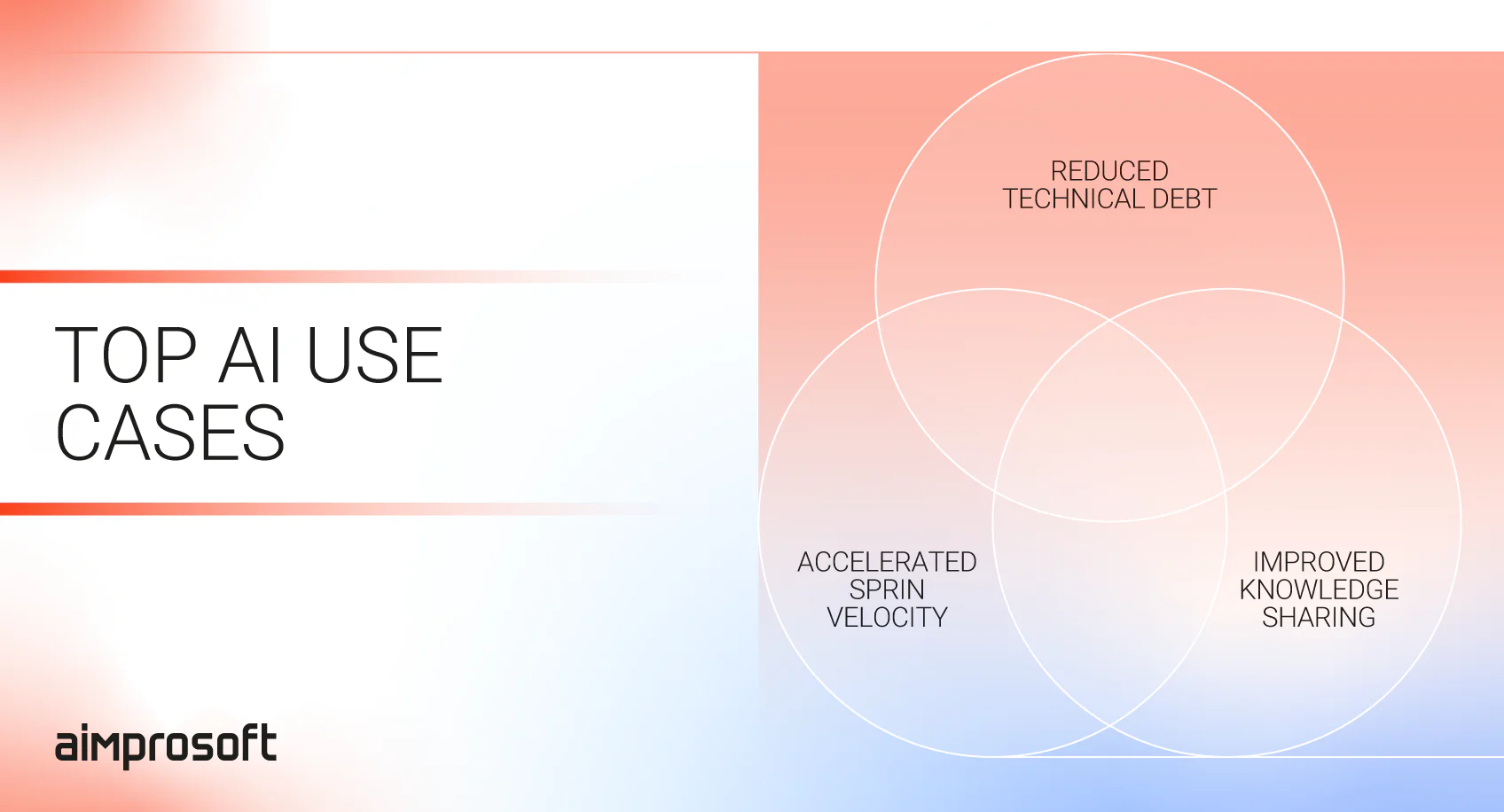AI-Powered Software Development: How AI Accelerates Software Development by 30% Without Additional Hires

A full-time in-house developer in the U.S., according to Indeed, might cost anywhere from $120,000 to $190,000 annually. And that’s before factoring in fringe benefits and overhead expenses. Once fully loaded, costs easily surpass $200,000 per developer each year. Sure, expertise comes at a price—but it’s not always a practical option for every business.
When companies are pushed to optimize resources and achieve more with less, they naturally gravitate toward cost-effective alternatives, like AI-assisted software development. AI staff augmentation provides a practical middle ground between hiring costly full-time developers and maintaining lean teams. Looking at the numbers, AI subscriptions for businesses typically cost just a fraction of hiring a full-time developer—often only a few thousand dollars up to around $50,000 per user annually.
So, what does AI-assisted programming mean in practical terms? Reduced hiring overhead, accelerated development cycles, and faster time-to-market. As a result, AI is reshaping software development, allowing teams to deliver more without expanding headcount.
If you’re curious about how this might fit your company’s needs, we’d love to share more. As a company that integrates AI into workflows, we know firsthand how important careful decision-making is.
Join us as we unpack the practical benefits of AI-powered development.
Top AI use cases in software development
If you are researching AI in software development or the AI assisted software development life cycle (AI SDLC), you’ve probably noticed some common themes. AI tools help developers spend less time on repetitive tasks. They suggest code improvements and can even translate plain language into working algorithms.
These capabilities bring clear benefits, such as faster time-to-market or fewer bugs. And it’s not just engineers who benefit; businesses gain significant advantages as well.
However, AI potential doesn’t end at “surface-level issues.” It can tackle deeper, more complex problems like technical debt, improve sprint velocity, and enhance knowledge sharing across teams. And today, we’ll explore these AI use cases together.

Reducing technical debt
For a long time, technical debt was considered a necessary evil in software development. A compromise: developers agreed to deliver features quickly, knowing they’d eventually have to pay it back through maintenance. It’s much like the debt you rack up from impulsive shopping on a credit card: convenient in the moment but costly and burdensome later on.
According to Insight, 86% of companies have been impacted by technical debt over the past 12 months (as of 2023). This bottleneck severely impacted their ability to innovate, meet service commitments (SLAs), and prevent downtime. As for developers, numbers are also unpleasant. Stripe report reveals that developers spend over 17 hours per week—Every. Single. Week—dealing with technical debt and fixing poorly written code instead of creating something new.
In an attempt to solve the issue, the industry has shifted its focus toward writing “clean code” from day one—code that’s readable, easy to maintain, and scalable. But writing robust code takes more time, attention, and experience. And highly skilled developers who can consistently produce clean code are expensive and difficult to find.
This is where AI-assisted coding tools step in. By providing real-time recommendations, automated quality checks, and immediate feedback to help developers write better, cleaner code with less effort, streamlining both the fixing of legacy code and reducing code rewrites.
By making maintainable coding accessible and intuitive, AI-augmented software development empowers developers to spend less time fixing problems and more time building innovative solutions. For businesses, AI tools for software development translate directly into faster releases, lower maintenance costs, and greater productivity—all without needing to grow the engineering team.
Accelerating sprint velocity
Sprint velocity is a key metric in agile project management. It measures the amount of work a development team can complete within a single sprint (a short, time-boxed period, often two weeks).
Project managers (PMs) closely monitor sprint velocity to accurately forecast project timelines, identify bottlenecks early, and allocate resources effectively. They often use historical data to plan future sprints and adjust project scopes as needed. However, human factors, such as team morale or unexpected roadblocks, can make velocity unpredictable. This is where the impact of AI on software development becomes invaluable.
AI-assisted development tools analyze past sprint performance, highlighting estimation inaccuracies and recommending realistic workloads. For example, if your historical data indicates that similar tasks require more effort than anticipated, AI helps teams refine their estimates proactively. By using AI to manage tasks, foresee problems, and set realistic targets, dedicated teams can deliver consistent, high-quality work without experiencing burnout.
Beyond planning, AI also enhances developers’ daily work. AI in software engineering acts as a virtual pair programmer, one that understands context, suggests relevant code snippets, and completes routine implementations automatically. Because these AI assistants learn from millions of lines of high-quality code, their suggestions improve coding standards across your whole team, ensuring everyone consistently produces better code.
With predictable sprints and consistently high-quality code, companies can confidently deliver value to customers and maintain a strong competitive edge.
Streamlining knowledge transfer
Documentation has been a painful bottleneck in software development for a long time. Developers dislike writing it, yet poor documentation notably slows onboarding and maintenance. AI-powered documentation tools change this by automatically generating technical docs, API references, and user guides based on the codebase.
According to a McKinsey & Company study, AI tools for software development can reduce the time spent on code documentation by 45-50%. What does this mean for your team? Your developers can spend more time building and improving software rather than writing docs. This efficiency boost not only accelerates workflows but also ensures more consistent and up-to-date documentation, helping you avoid costly errors that come from outdated or missing information.
For businesses, this eliminates knowledge silos and dependency on key individuals. We’ve all met them—team members who keep documentation in their heads, only for that knowledge to disappear when they leave. While AI ensures that documentation remains accessible and accurate, making it easier for teams to share critical knowledge.
Implementing an AI strategy framework
Implementing AI for software development services takes more than just purchasing a license. Successful integration of AI in the workforce requires a structured approach that considers both technology and human factors. Many companies adopt AI tools yet struggle to see real impact due to poor integration and a lack of clear strategies.
To address this issue, we developed the Aimpro Framework—an AI framework that enhances development team productivity, streamlines processes, and delivers measurable value.
Let’s walk through each component.

Assessment of development bottlenecks
The first step in a tutorial on “how to use AI in software development” is identifying where your development process is experiencing friction. Rather than applying AI tools everywhere, we suggest focusing on areas where improvements will yield the best returns.
To do this, start by collecting data on current workflows. Which phases of development consistently run behind schedule? Where do your developers spend most of their time? Which tasks do they find most tedious or error-prone?
By pinpointing these bottlenecks, you lay the foundation for targeted AI solutions.
Many organizations share common bottlenecks:
- Slow code reviews – Senior engineers get overwhelmed, delaying development.
- Inefficient testing – Takes too much time but still misses critical bugs.
- Outdated documentation – Hard to maintain, making onboarding difficult.
- Growing technical debt – Piles up faster than teams can fix it.
- Inconsistent code standards – Varying styles across teams create integration challenges.
Once you’ve identified your team’s most pressing issues, you can implement AI solutions that directly address them, rather than using artificial intelligence in software engineering just for the sake of it.
This leads us to the next crucial step, selecting specific AI tools.
AI tool selection criteria
Not all AI development tools are created equal, so choosing the right solution for your team requires careful evaluation against several criteria.
- Integration capabilities: Choose tools that connect with your existing development environment and tech stack. If your team uses VSCode and GitHub, prioritize AI solutions with native support for these platforms. This way, you ensure a smooth transition and minimize disruption to your team’s workflow.
- Learning curve: Assess how quickly your team can start using the tool effectively. Some AI software engineering tools take time to set up and learn, but others give you quick wins with almost no work. Consider your team’s existing skill set and available training resources when making this decision.
- Model options: For full control choose open-source models such as LLaMA and DeepSeek-R1. They let you fine-tune AI to your needs but require technical expertise. If you need a faster, hassle-free setup, cloud-based options like GPT-4 or Claude are a better fit.
- Security and compliance: For businesses handling sensitive data or operating in regulated industries, verify that AI tools meet your security requirements. Pay attention to points like GDPR compliance, data processing locations, and privacy guarantees. Meeting these standards is crucial for maintaining trust and safeguarding sensitive information.
After selecting AI tools, the next step is to ensure a smooth technical implementation. Here’s how to get started.
Technical implementation plan
With strategic decisions made, it’s time to execute your AI integration through three key technical steps:
#1. Set up AI infrastructure
Before starting AI-augmented software engineering, it’s crucial to establish a strong technical foundation. A well-prepared infrastructure ensures smooth implementation and maximizes AI’s benefits. Here are two key areas to focus on:
- Hardware requirements: Depending on your chosen solution, you may need a dedicated server with GPU capabilities for local deployments. This hardware provides the processing power needed to perform AI tasks efficiently.
- Containerization: Tools like Docker or Kubernetes can make deployment and management much easier. By packaging AI models and their dependencies into containers, teams can maintain consistency across environments, simplify setup, and streamline updates.
#2. Deploy and configure AI models
Once the infrastructure is ready, make sure the AI models are configured correctly for your development. What matters most:
- Model Configuration: Set batch size (number of inputs processed at once), token length (amount of text handled per request), and context window (extent of past interactions the model retains) to match development needs. Fine-tuning ensures optimal performance for specific requirements.
- Optimization: Use techniques like quantization, which reduces the model’s size by simplifying how it stores information (like compressing a file), to improve AI response times while maintaining accuracy.
#3. Create developer access points
Next, make AI capabilities easily accessible to your development team.
- API Development: Create well-documented API endpoints for different development tasks. API development allows developers to integrate AI functionalities into their workflows easily.
- IDE Integration: Implement plugins or extensions for your team’s preferred development environments. IDE integration streamlines AI usage within the familiar development environment.
Yet, simply deploying AI isn’t enough—true value comes when it seamlessly fits into your team’s workflow.
Integration with existing workflows
AI tools deliver the greatest value when they enhance established workflows rather than forcing teams to adopt entirely new processes. So, how to do it effectively?
- Start small: Begin with a single team or project to validate benefits before rolling out AI tools company-wide.
- Embed AI at decision points: Identify key moments in your development process where AI assistance would be most valuable, such as during code creation, review, or testing.
- Automate repetitive tasks: Configure AI to handle routine work automatically, like generating unit tests or updating documentation when code changes.
Note that AI adoption doesn’t stop at integration; it requires ongoing monitoring and refinement to deliver lasting impact.
Continuous monitoring and improvement
To ensure AI for software engineering remains a strategic advantage, businesses must actively monitor its performance. The most successful integration of AI and software engineering relies on continuous feedback and refinement. Regular tracking, updates, and developer feedback help AI evolve alongside your development needs.
- Performance tracking: Monitor response times, accuracy, and usage patterns to find ways to improve. For example, if you notice your AI code suggestions are taking longer than 2 seconds to generate. In that case, you might need to adjust your model parameters or upgrade your infrastructure.
- Regular updates: Keep AI models current with the latest versions and improvements. Schedule regular update cycles to add new capabilities and security patches, just as you would with any critical development tool.
- Feedback loop: Collect developer input to refine how AI is continuously integrated into your workflows. Create simple feedback mechanisms (like quick surveys or dedicated Slack channels) where developers can report both successes and challenges with the AI tools.
By following this framework—from assessment to implementation and continuous improvement—you can leverage AI for software development to boost efficiency and empower your AI staff without increasing headcount.
Want to learn how to tackle the most common AI challenges? Check our in-depth guide
Benefits of AI in software development
Many companies still hesitate to integrate AI software development solutions into their workflows, citing concerns about learning curves and uncertain ROI. Meanwhile, industry leaders are proving AI’s impact—leveraging AI software engineering to accelerate development cycles, AI-assisted testing to enhance code quality, and automation to improve the delivery process.
One of the bright examples is JPMorgan Chase. A global leader in financial services deployed AI-powered coding assistants across its engineering teams, achieving notable results: 10% to 20% efficiency boost. Developers dedicate less time to repetitive coding and can shift their efforts toward high-value initiatives.

Another example is IBM. The company invited its own AI staff to test IBM Watsonx Code Assistant in their daily work. This approach to staff augmentation engineering allowed them to enhance capabilities without expanding headcount. Across multiple teams, IBM reported:
- 56% reduction in time spent understanding code, with AI-powered explanations facilitating faster navigation of complex codebases.
- 59% reduction in time spent on documentation, thanks to automated tools that ensured more accurate and up-to-date records.
- 38% acceleration in code generation and test case creation, leading to faster iterations and reduced manual coding overhead.
For businesses looking to increase developer productivity without expanding their teams, AI offers a tangible, cost-effective advantage. At Aimprosoft, we’ve seen this impact firsthand—on one client project, our augmented staff leveraged AI to enhance overall performance by up to 30% using our structured AI framework.
These results aren’t exceptions—they’re what’s possible with the right strategy and execution.
We know that taking the first steps towards artificial intelligence software development services can be daunting. From identifying key bottlenecks to selecting the tools. But with the right software development partner, it’s easier than you think.
If you’re exploring AI adoption and want practical, experience-backed AI business consulting, our team is happy to discuss the best steps to take.




